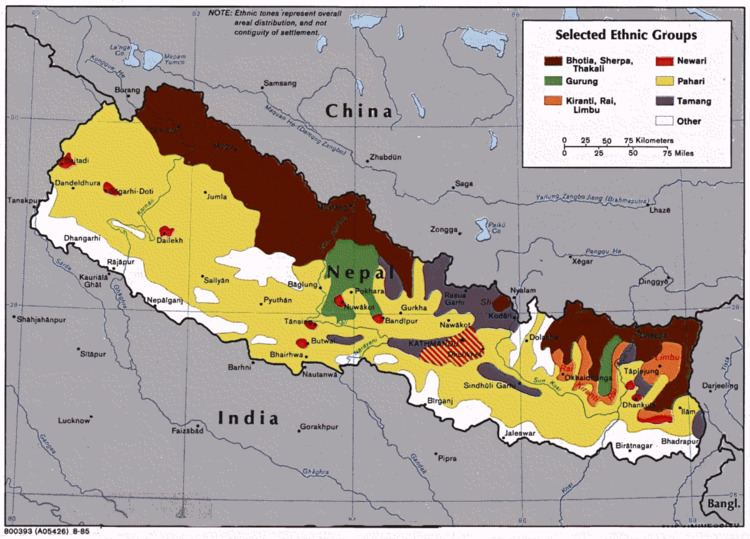 | ||
Bhotiya or Bot (Nepali: भोटिया, Bhotiyā) are groups of ethno-linguistically related Tibetan people living in the Transhimalayan region of the SAARC countries. The word Bhotiya comes from the classical Tibetan name for Tibet, Bod. The Bhotiya speak Ladakhi, a Tibetic language.
Contents
Background
The Bhotiya identify as Raghuvanshi Rajput and prefer to be referred as Thakur or Rajvanshi. The Bhotiya may be the original immigrants to north Oudh in the period of Nawab Asaf-Ud-Dowlah (1775 to 1797).
The Bhotiya people are closely related to several other groups and ethnic boundaries are porous. One group is the Bhutia, the main ethnolinguistic group of the northern part of the Indian state of Sikkim. A second is the Uttarakhand Bhotiya of the upper Himalayan valleys of the Kumaon and the Garhwal divisions of Uttarakhand. These include the Shauka tribe of Kumaon, the Tolchhas and the Marchhas of Garhwal. A third related group are the Dzongkha speaking Ngalop people, the main ethnolinguistic group of Bhutan. The Bhotiya are also related to several dispersed groups in Nepal and the adjacent areas of India including the Tibetans and Sherpas.
In Nepal, Bhotiya are 0.1 percent of the population. They live in villages through the Himilayas.
Language of the Bhotiya people
The language of the Bhotiya people is Ladkahi (Bhoti). It is usually written in the Tibetan alphabet. Bhoti is spoken in Himachal Pradesh, Sikkim, Uttarakhand, Arunachal Pradesh, Bhutan, Nepal, Tibet, and parts of Pakistan and West Bengal. Bhoti is not included in the languages with official status in India. On 27 February 2011, however, a resolution introduced by the Ladakh Autonomous Hill Development Council, Leh, for the inclusion of the language in the Eighth Schedule to the Constitution of India passed without opposition.
Population
The Bhotiya, recognised by Mongoloid facial features, live in the northern and eastern regions of Nepal, where they and other Tibetans are the region's autochthonous (indigenous) people. The Bhotiya also live in the Indian states of Jammu and Kashmir, Himachal Pradesh, Uttarakhand, Uttar Pradesh, West Bengal, Sikkim, Arunachal Pradesh and Tripura. In Uttar Pradesh, the Bhotiya live in the Bahraich, Gonda, Lakhimpur, Lucknow, Barabanki, Kanpur, and Kheri districts.
The Bhotiya have six recognisable sub-groups: the Bhot, Bhotiya, the Bhutia of Sikkim, the Tibbati (of Sikkim and Arunachal Pradesh), the Bhut, the Gyakar Khampa of Khimling, Bhidang of Uttarakhand and the Bhutola.
In Jammu and Kashmir, Himachal Pradesh, Sikkim and Arunachal Pradesh, the Bhotiya people have Scheduled Tribe status. In Uttarakhand, the Bhotiya are a Scheduled Tribe under the "Schedule caste order 1950, the constitutional Scheduled tribe (Uttar Pradesh) 1967 SC/ST." The Constitution of India recognizes the Bhotiya.
Weddings
Bhotiya marriages are similar to Hindu weddings. When the bride's palanquin arrives at her husband's house, gods are worshipped and then she is admitted to the house. Rice, silver or gold is put in the hands of bridegroom, which he passes on to the bride. She places them in a winnowing fan, and hands them as a present to the wife of the barber. This ceremony is known as Karj Bharna. A man may have not more than three wives. The first wife is the head wife, and she inherits an additional one tenth of the husband's estate.
Funerals
The Bhotiyas have distinctive funerary traditions. Young children who die of cholera or snakebite are buried while others are cremated. There is no fixed burial ground, and no ceremonies are performed at the time of burial. The wealthy keep the ashes for lowal to several streams, while others bury them. After cremation, a stalk of kusha (grass) is fixed in the ground near a tank of water and sesamum is poured on it for ten days. This makes it a refuge for the deceased's spirit until the rites are completed.
Religion
Most Bhotiya practice a combination of Tibetan Buddhism and Hinduism. (The word Bhotiya is derived from the word Bhot, meaning Buddha.) Ancestor worship is prevalent.
Hindu Bhutia
Bhutia is also the surname of Marwari people of Brahmin caste. They worship deity Ramdev Pir, Khatushyam & Salasar Balaji as Ishta-deva.
Buddhist Bhotiyas
Buddhist Bhotiyas engage a Lama to perform rites and celebrations. In Buddhism, correct thinking, ritual sacrifices, and self-denial will enable the soul to break the cycle of reincarnation and reach Nirvana (a state of eternal bliss) at death. Only those who follow the middle way and the noble eight-fold path can achieve that state. The Bhotiya are lamaistic Buddhists who follow the teachings of the Dalai Lama.
In Uttarakhand, the Bhotiya may acknowledge superstitions, amulets for good luck, curses, ghosts and witchcraft. Believers may appease their divinities with religious chants, rituals, and sacrifices.
The Buddhist Bhotiyas celebrate the Losar festival during the flowering of the apricot trees in autumn. Incense is offered to appease local spirits and deities.
Economy
In Uttarakhand, particularly Chamoli, Pithoragarh and Uttarkashi, the Bhotiya are nomadic, migratory pastoralists, moving about the border lands between India and Tibet.and also live in Pakistan with bhutta and bhutto name
They are also traders in the Himilayas for products such as, cereal, wool and salt. Now, some are farmers and others are merchants of stones, gems and herbs.
The Bhotiya are experienced in the use of medicinal plants. The local fermented beverages are jan (a local beer), and daru. A local fermented food stuff is sez. The traditional catalyzing agent used in the preparation of fermented foods and beverages is called balam in the Kumaon Division and balma in Garhwal Division.
A cottage wool industry employs many Bhotiya. Women weave pattu, a coarse woolen serge. Plants are collected to make natural dyes for colouring the wool.
